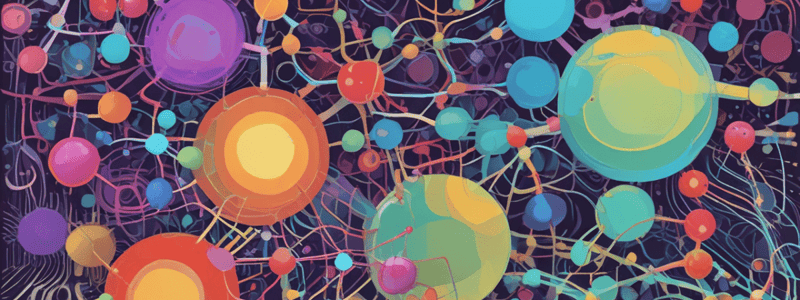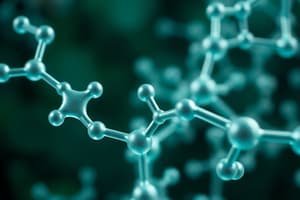Podcast
Questions and Answers
What is the result of brain cells lacking glucose?
What is the result of brain cells lacking glucose?
- Coma (correct)
- Malnutrition
- Diabetes
- Death due to vomiting
What is the scientific name of the amino acid found in the ackee?
What is the scientific name of the amino acid found in the ackee?
- Cyclopropyl acid
- Hypoglycin-B
- L-α-amino-β-methylene cyclopropyl propionic acid (correct)
- Amino acid-A
What is the fate of the carbon skeletons of amino acids when used as fuel?
What is the fate of the carbon skeletons of amino acids when used as fuel?
- Formation of hormones
- Oxidation to CO2 via TCA and conversion into glucose (correct)
- Conversion into proteins
- Storage in the liver
What is the purpose of digestion in the context of amino acid metabolism?
What is the purpose of digestion in the context of amino acid metabolism?
What is the term for each amino acid in a polypeptide chain?
What is the term for each amino acid in a polypeptide chain?
What is the role of amino acids in higher animals?
What is the role of amino acids in higher animals?
Where does the formation of citrulline occur?
Where does the formation of citrulline occur?
What is the enzyme responsible for forming arginino succinate?
What is the enzyme responsible for forming arginino succinate?
What is the source of the second amino group required for urea synthesis?
What is the source of the second amino group required for urea synthesis?
What is the byproduct of the reaction that forms arginino succinate?
What is the byproduct of the reaction that forms arginino succinate?
What is the purpose of pyrophosphatase in the formation of arginino succinate?
What is the purpose of pyrophosphatase in the formation of arginino succinate?
What is the total number of ATP molecules consumed in the formation of arginino succinate?
What is the total number of ATP molecules consumed in the formation of arginino succinate?
What is the primary function of transamination during the oxidative degradation of amino acids?
What is the primary function of transamination during the oxidative degradation of amino acids?
What is the result of transamination on an α-amino acid?
What is the result of transamination on an α-amino acid?
What is the role of transaminases in transamination?
What is the role of transaminases in transamination?
What is the fate of the amino group removed during transamination?
What is the fate of the amino group removed during transamination?
How many amino acids are involved in transamination during their oxidative degradation?
How many amino acids are involved in transamination during their oxidative degradation?
What is the reactant that receives the α-amino group during transamination?
What is the reactant that receives the α-amino group during transamination?
What is responsible for the colour change in the urine of individuals with Alcaptonuria?
What is responsible for the colour change in the urine of individuals with Alcaptonuria?
Which disease is characterized by eye and skin lesions and sometimes mental retardation?
Which disease is characterized by eye and skin lesions and sometimes mental retardation?
What is the effect of lack of pigmentation in the eyes of individuals with Albinism?
What is the effect of lack of pigmentation in the eyes of individuals with Albinism?
What is the deficiency responsible for Albinism?
What is the deficiency responsible for Albinism?
Which disease is related to Phenylalanine?
Which disease is related to Phenylalanine?
What is the effect of skin sensitivity to sunlight in individuals with Albinism?
What is the effect of skin sensitivity to sunlight in individuals with Albinism?
What is the primary source of thyroid-stimulating hormone (TSH)?
What is the primary source of thyroid-stimulating hormone (TSH)?
What is the result of iodination of tyrosyl residues in protein?
What is the result of iodination of tyrosyl residues in protein?
Which of the following is a characteristic of thyrotoxicosis?
Which of the following is a characteristic of thyrotoxicosis?
What is the fate of monoidotyrosine (MIT) in the synthesis of thyroid hormones?
What is the fate of monoidotyrosine (MIT) in the synthesis of thyroid hormones?
What is the significance of a low iodine content in the thyroid gland?
What is the significance of a low iodine content in the thyroid gland?
What is the significance of a higher proportion of triiodothyronine (T3) to thyroxine (T4)?
What is the significance of a higher proportion of triiodothyronine (T3) to thyroxine (T4)?
Study Notes
Amino Acids and Glucose Metabolism
- Brain cells are highly dependent on glucose; lack of glucose can lead to energy deficits and neuronal dysfunction.
- The scientific name for the amino acid found in ackee is hypoglycin A, known for its toxic effects when consumed in unripe fruit.
Amino Acid Fuel and Metabolism
- Carbon skeletons of amino acids, when used as fuel, are converted into intermediates that enter the citric acid cycle for energy production.
- Digestion is essential in amino acid metabolism to break down proteins into amino acids for absorption and subsequent usage in various bodily functions.
Polypeptide Structure and Function
- Each amino acid in a polypeptide chain is termed a residue, contributing to the protein's structure and function.
- Amino acids serve various roles in higher animals, including serving as building blocks for proteins, precursors for hormones, and involvement in metabolic pathways.
Citrulline Formation and Urea Cycle
- Formation of citrulline occurs in the mitochondria, a key step in the urea cycle to remove excess nitrogen from the body.
- The enzyme responsible for forming argininosuccinate is argininosuccinate synthetase, crucial for the urea synthesis pathway.
Urea Synthesis and Byproducts
- The second amino group required for urea synthesis is sourced from aspartate.
- Byproduct of the reaction forming argininosuccinate is fumarate, which is utilized in the citric acid cycle.
Role of Enzymes in Urea Cycle
- Pyrophosphatase catalyzes the hydrolysis of pyrophosphate, driving the formation of argininosuccinate forward.
- A total of 2 ATP molecules are consumed in the formation of argininosuccinate, reflecting energy investment in urea synthesis.
Transamination Process
- Primary function of transamination during oxidative degradation of amino acids is to convert non-essential amino acids to other amino acids, enabling energy production.
- Transamination results in the conversion of an α-amino acid to a corresponding α-keto acid, facilitating amino acid interconversion.
Enzymatic Roles in Transamination
- Transaminases are specialized enzymes that facilitate the transfer of amino groups between amino acids and α-keto acids.
- The fate of the removed amino group during transamination is to be incorporated into another α-keto acid, forming a new amino acid.
Diseases Related to Amino Acid Metabolism
- Alcaptonuria is characterized by a urine color change due to the accumulation of homogentisic acid, a byproduct of tyrosine metabolism.
- A disease characterized by eye and skin lesions, sometimes resulting in mental retardation, is associated with phenylketonuria (PKU).
Albinism and Related Deficiencies
- Lack of pigmentation in the eyes of individuals with albinism leads to increased sensitivity to light and risk of vision problems.
- Deficiency of the enzyme tyrosinase is responsible for albinism, affecting melanin production.
Thyroid Hormone Synthesis
- The primary source of thyroid-stimulating hormone (TSH) is the anterior pituitary gland, regulating thyroid function.
- Iodination of tyrosyl residues in proteins is necessary for the synthesis of thyroid hormones, impacting metabolic regulation.
Thyrotoxicosis and Iodine Significance
- Thyrotoxicosis is characterized by hypermetabolism, weight loss, and increased heart rate, reflecting excessive thyroid hormone levels.
- Fate of monoidotyrosine (MIT) during thyroid hormone synthesis involves conversion to diiodotyrosine (DIT) and further coupling to form T3 and T4.
Importance of Iodine Levels
- Low iodine content in the thyroid gland can lead to goiter and hypothyroidism due to inadequate hormone synthesis.
- A higher proportion of triiodothyronine (T3) to thyroxine (T4) is significant for metabolic activity, as T3 is more biologically active than T4.
Studying That Suits You
Use AI to generate personalized quizzes and flashcards to suit your learning preferences.
Related Documents
Description
This quiz covers the structural and functional aspects of Hypoglycin-A, a toxic compound found in ackee fruit, and its relation to amino acids, polypeptides, and enzymes. Learn about the effects of Hypoglycin-A on the body, including hypoglycemia and its consequences. Test your knowledge of biochemistry and molecular biology!




